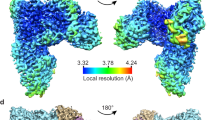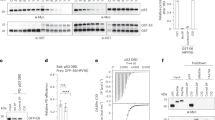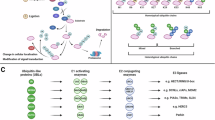Abstract
The Discs Large (DLG) tumour suppressor protein is targeted for ubiquitin mediated degradation by the high risk human papillomavirus (HPV) E6 proteins. In this study we have used a mutational analysis of E6 in order to investigate the mechanism by which this occurs. We first show that the differences in the affinities of HPV-16 and of HPV-18 E6 proteins for binding DLG is reflected in their respective abilities to target DLG for degradation. A mutational analysis of HPV-18 E6 has enabled us to define regions within the carboxy terminal half of the protein which are essential for the ability of E6 to direct the degradation of DLG. Mutants within the amino terminal portion of E6 which have lost the ability to bind the E6-AP ubiquitin ligase, as measured by their ability to degrade p53, nonetheless retain the ability to degrade DLG. Significant levels of DLG degradation are also obtained using wheat germ extracts which lack E6-AP. Finally, we show that the transfer of the DLG binding domain onto the low risk HPV-6 E6 confers DLG binding activity to that protein and, most significantly, allows HPV-6 E6 to target DLG for degradation. These results indicate that E6 mediated degradation of DLG does not involve the E6-AP ubiquitin ligase and, in addition, shows that the high and low risk HPV E6 proteins most likely share a common cellular intermediary in the ubiquitin pathway.
This is a preview of subscription content, access via your institution
Access options
Subscribe to this journal
Receive 50 print issues and online access
$259.00 per year
only $5.18 per issue
Buy this article
- Purchase on SpringerLink
- Instant access to full article PDF
Prices may be subject to local taxes which are calculated during checkout








Similar content being viewed by others
References
Androphy E, Hubbert N, Schiller J and Lowy D. . 1987 EMBO J. 6: 989–992.
Banks L, Spence P, Androphy E, Hubbert N, Matlashewski G, Murray A and Crawford L. . 1987 J. Gen. Virol. 68: 1351–1359.
Barbosa MS and Schlegel R. . 1989 Oncogene 4: 1529–1532.
Barnes W, Delgado G, Kurman RJ, Petrilli ES, Smith DM, Ahmed S, Lorincz AT, Temple GF, Jenson AB and Lancaster WD. . 1988 Gynecol. Oncol. 29: 267–273.
Burnett AF, Barnes WA, Johnson JC, Grendys E, Willett GD, Barter JF and Doniger J. . 1992 Gynecol. Oncol. 47: 343–347.
Crook T, Ludwig R, Marston N, Willkomm D and Vousden KH. . 1996 Virology 217: 285–292.
Crook T, Tidy J and Vousden KH. . 1991 EMBO J. 11: 3935–3940.
Dyson N, Howley PM, Münger K and Harlow E. . 1989 Science 243: 934–936.
Foster S, Demers W, Etscheid B and Galloway D. . 1994 J. Virol. 68: 5698–5705.
Gardiol D and Banks L. . 1998 J. Gen. Virol. 79: 1963–1970.
Gardiol D, Kühne C, Glaunsinger B, Lee SS, Javier R and Banks L. . 1999 Oncogene 18: 5487–5496.
Goode S and Perrimon N. . 1997 Genes Dev. 11: 2532–2544.
Hiraiwa A, Kiyono T, Segawa K, Utsumi KR, Ohashi M and Ishibashi M. . 1993 Virology 192: 102–111.
Huibregtse J, Scheffner M and Howley P. . 1991 EMBO J. 10: 4129–4135.
Huibregtse J, Scheffner M and Howley P. . 1993 Mol. Cell. Biol. 13: 775–784.
Inoue T, Oka K, Yong-II H, Vousden KH, Kyo S, Jing P, Hakura A and Yutsoda M. . 1998 Mol. Carcinog. 21: 215–222.
Ishiwatari H, Hayasaka N, Inoue H, Yutsudo M and Hakura A. . 1994 J. Med. Virol. 44: 243–249.
Kim E, DeMarco S, Marfatia S, Chishti A, Sheng M and Strehler E. . 1998 J. Biol. Chem. 273: 1591–1595.
Kim E, Niethammer M, Rothschild A, Nung Jan Y and Sheng M. . 1995 Nature 378: 85–88.
Kim S. . 1997 Curr. Opin. Cell Biol. 9: 853–859.
Kiyono T, Hiraiwa A, Fujita M, Hayashi Y, Akiyama T and Ishibashi M. . 1997 Proc. Natl. Acad. Sci. USA 94: 11612–11616.
Kurman RJ, Schiffman MH, Lancaster WD, Reid R, Jenson AB, Temple GF and Lorincz AT. . 1988 Am. J. Obstet. Gynecol. 159: 293–296.
Lee SS, Weiss R and Javier R. . 1997 Proc. Natl. Acad. Sci. USA 94: 6670–6675.
Li X and Coffino P. . 1996 J. Virol. 70: 4509–4516.
Lue R, Marfatia S, Branton D and Chishti A. . 1994 Proc. Natl. Acad. Sci. USA 91: 9818–9822.
Marfatia S, Morais Cabral J, Lin L, Hough C, Bryant P, Stolz L and Chishti A. . 1996 J. Cell. Biol. 135: 753–766.
Matlashewski G, Schneider J, Banks L, Jones N, Murray A and Crawford L. . 1987 EMBO J. 6: 1741–1746.
Matsumine A, Ogai A, Senda T, Okumura N, Satoh K, Baeg G, Kawahara T, Kobayashi S, Okada M, Toyoshima K and Akyama T. . 1996 Science 272: 1020–1023.
Muller B, Kistner U, Veh R, Cases-Langhoff C, Becker B, Gundelfinger E and Garner C. . 1995 J. Neuroscience 15: 2354–2366.
Nakagawa S, Watanabe S, Yoshikawa H, Taketani Y, Yoshiike K and Kanda T. . 1995 Virology 212: 535–542.
Pim D and Banks L. . 1999 Oncogene 18: 7403–7408.
Pim D, Massimi P and Banks L. . 1997 Oncogene 15: 257–264.
Pim D, Storey A, Thomas M, Massimi P and Banks L. . 1994 Oncogene 9: 1869–1876.
Ponting C and Phillips C. . 1995 Trends Biochem. Sci. 20: 102–103.
Saras J and Heldin C. . 1996 Trends Biochem. Sci. 21: 455–458.
Scheffner M, Huibregtse J, Vierstra R and Howley P. . 1993 Cell 75: 495–505.
Scheffner M, Münger K, Byrne JC and Howley P. . 1990 Cell 63: 1129–1136.
Schwarz E, Freese U, Gissmann L, Mayer W, Roggenbuck B, Stremlau A and zur Hausen H. . 1985 Nature 314: 111–114.
Smotkin D and Wettstein F. . 1986 Proc. Natl. Acad. Sci. USA 83: 4680–4684.
Song S, Pitot HC and Lambert PF. . 1999 J. Virol. 73: 5887–5893.
Thomas M, Massimi P, Jenkins J and Banks L. . 1995 Oncogene 10: 261–268.
Villa LL and Schlegel R. . 1991 Virology 181: 374–377.
Woods D, Hough C, Peel D, Callaini G and Bryant P. . 1996 J. Cell. Biol. 134: 1469–1482.
Werness B, Levine A and Howley P. . 1990 Science 248: 76–79.
Zhang J, Rose BR, Thompson CH, Jarrett C, Russell P, Houghton RS and Cossart YE. . 1995 Gynecol. Oncol. 57: 170–177.
zur Hausen H. . 1991 Virology 184: 9–13.
zur Hausen H and Schneider A. . 1987 In: The Papovaviridae vol. 2: pp. 245–263.
Acknowledgements
We are most grateful to Christian Kühne for comments on the manuscript. This work was supported in part by a research grant from the Associazione Italiana per la Ricerca sul Cancro to L Banks and grants from the National Institutes of Health (ROI CA58541), American Cancer Society (RPG-97-668-01-VM) and US Army (DAMD17-97-1-7082) to R Javier.
Author information
Authors and Affiliations
Rights and permissions
About this article
Cite this article
Pim, D., Thomas, M., Javier, R. et al. HPV E6 targeted degradation of the discs large protein: evidence for the involvement of a novel ubiquitin ligase. Oncogene 19, 719–725 (2000). https://doi.org/10.1038/sj.onc.1203374
Received:
Revised:
Accepted:
Published:
Issue date:
DOI: https://doi.org/10.1038/sj.onc.1203374
Keywords
This article is cited by
-
Inhibition of kinase IKKβ suppresses cellular abnormalities induced by the human papillomavirus oncoprotein HPV 18E6
Scientific Reports (2021)
-
Roles of the PDZ domain-binding motif of the human papillomavirus type 16 E6 on the immortalization and differentiation of primary human foreskin keratinocytes
Virus Genes (2014)
-
Human papillomaviruses, cervical cancer and cell polarity
Oncogene (2008)
-
Cell polarity proteins: common targets for tumorigenic human viruses
Oncogene (2008)
-
HPV E6 degradation of p53 and PDZ containing substrates in an E6AP null background
Oncogene (2008)



